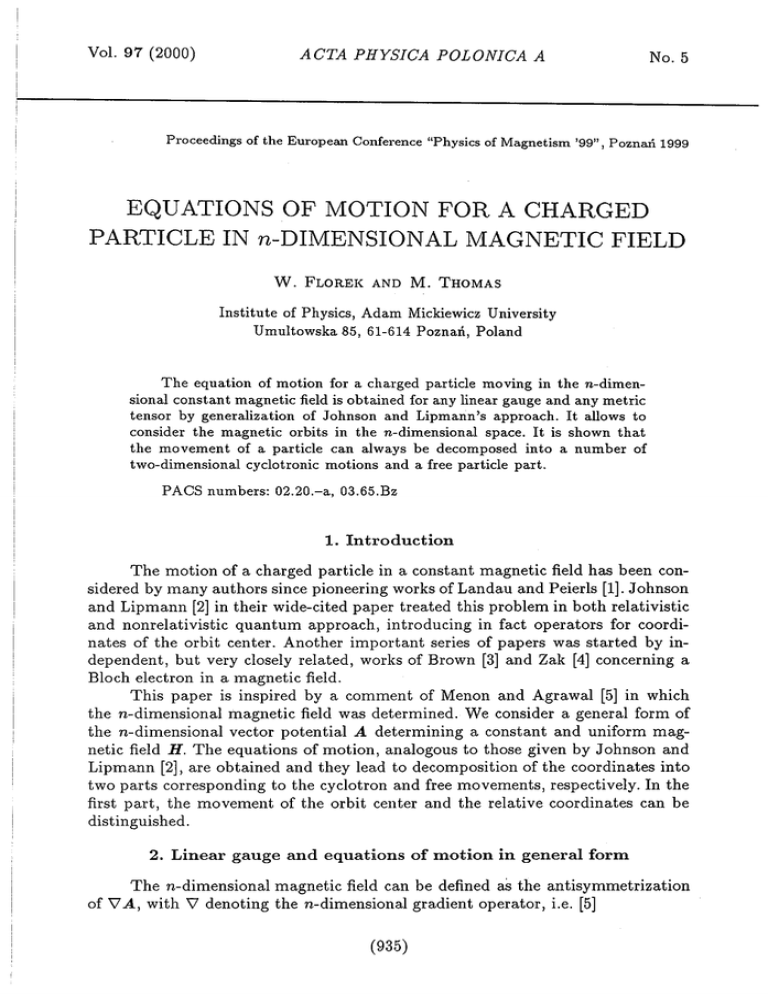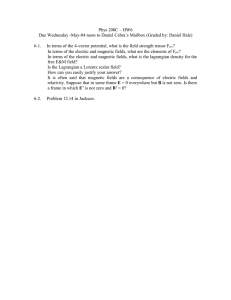EQUATIONS OF MOTION FOR A CHARGED PARTICLE IN n
advertisement

Vol. 97 (2000) ACTA PHYSICA POLONICA A No. 5
Proceedings of the European Conference "Physics of Magnetism '99", Poznań 1999
EQUATIONS OF MOTION FOR A CHARGED
PARTICLE IN n-DIMENSIONAL MAGNETIC FIELD
W. LOREK AND Μ. THOMAS
Institute of Physics, Adam Mickiewicz University
Umultowska 85, 61-614 Poznań, Poland
The equation of motion for a charged particle moving in the n-dimensional constant magnetic field is obtained for any linear gauge and any metric
tensor by generalization of Johnson and Lipmann's approach. It allows to
consider the magnetic orbits in the n-dimensional space. It is shown that
the movement of a particle can always be decomposed into a number of
two-dimensional cyclotronic motions and a free particle part.
PACS numbers: 02.20.-a, 03.65.Bz
1. Introduction
The motion of a charged particle in a constant magnetic field has been considered by many authors since pioneering works of Landau and Peierls [1]. Johnson
and Lipmann [2] in their wide-cited paper treated this problem in both relativistic
and nonrelativistic quantum approach, introducing in fact operators for coordinates of the orbit center. Another important series of papers was started by independent, but very closely related, works of Brown [3] and Zak [4] concerning a
Bloch electron in a magnetic field.
This paper is inspired by a comment of Menon and Agrawal [5] in which
the n-dimensional magnetic field was determined. We consider a general form of
the n-dimensional vector potential Α determining a constant and uniform magnetic field H. The equations of motion, analogous to those given by Johnson and
Lipmann [2], are obtained and they lead to decomposition of the coordinates into
two parts corresponding to the cyclotron and free movements, respectively. In the
first part, the movement of the orbit center and the relative coordinates can be
distinguished.
2. Linear gauge and equations of motion in general form
The n-dimensional magnetic field can be defined as the antisymmetrization
of VA, with V denoting the n-dimensional gradient operator, i.e. [5]
(935)
W. Florek, M. Thomas
936
where Α = (Α1 , Α 2 , ... , Α,) is an n-dimensional covariant function of the coordinates, Α Ξ .4(x), which can be referred to as the n-dimensional vector potential. If Α is a lineαr function of the coordinates then it can be expressed by an
(n x n)-matrix Α (a covariant tensor) as
(the Einstein convention is assumed throughout). Substituting it to (1) one obtains
that Η is simply the antisymmetrized tensor A, i.e.
so Η corresponds to a constant and uniform magnetic field. Working in the radiation
gauge the subsidiary condition V • Α = gjk∂jΑk = gjkΑjk = Ο has to be assumed.
In particular, this form includes the Landau gauge and the antisymmetric gauge
determined by Α = Η/2. By transposition of the matrix Α one obtains a magnetic
fi ΗΤ associa ed with H:
t
The Hamiltonian for a free particle in an external magnetic field, with the
effective mass m and the charge q, can be written as
with p being the canonical momentum, i.e. an n-dimensional covariant operator
These operators satisfy the commutation relation
so they do not commute for Η k ψ Ο. However, it is important in the further
considerations that these operators are numbers, i.e. commute with any operator. Equations of motion for p3 and xk are given by the commutators with the
Hamiltonian
This system of equations lead8 to the integrals of motion which can be determined
substituting ώ to p [2]
Taking into account the definitions (1) and (5) one obtains
Due to their definitions, operators p commute with the Hamiltonian but they do
not commute with each other
Equations of Motion for a Charged Particle ... 937
Note that for an antisymmetric gauge, Α = Η/2, one obtains
which agrees with the definitions of magnetic translations used by Brown and
Zak [3, 4]. The above presented form of p, allows us to consider any linear gauge
Α and to define the magnetic translations as unitary operators [3, 6, 71
3. Cyclotronic orbits
The definition (8) of pTk can be written as a set of equations for variables xl
Since Η is an antisymmetric matrix then its eigenvalues are equal to Ο or are
arranged in pairs of imaginary numbers ±χli, 1 = 1, 2, ..., N < n/2. Therefore,
there exists such an orthogonal basis {ε α }, α = 1, 2, ... , n, in which the magnetic
tensor consists of N two-dimensional antisymmetric blocks
Note that this basis can be obtained by a transformation Β which is orthogonal
with respect to a positive definite metric tensor -γ , not with respect to a general
metric tensor gjk. It means that one can choose the basis {ej} to be orthogonal
with respect to both forms, i.e. (ej) l (ek) m glm = gjk and (ej) l (ek)mγl m = Υjk but
a new basis ε α = Β ej is orthogonal, in general, with respect to the tensor γ only.
For example, in the most interesting case when g j j = 1 for j < n, g nn = -1
and Ο in the other cases with γ ' β = δ α β, corresponding to an (n + 1)-dimensional
space-time, the orthogonal transformation Β leads to a basis in which spatial and
time coordinates are mixed and some basis vectors ε α can be singular with respect
to gjk.
For the sake of clarity the coordinates of tensors (Hjk), (xk) and (pj(T)) in
the new basis will be denoted by the Greek letters with Greek indices, i.e. Θαβ , ξ ,
and π
respectively. Using this notation one can obtain (to simplify notation
the factor c/q is included in the definition of π(T))
,
The l-th block of the matrix 0 α 4, with 1 = 1, 2, ... , N < n/2, is given by (12),
so the set of Eqs. (11) can be rewritten as
Α form of the matrix Θ leads to a decomposition into two subsets of equations:
for odd coordinates 211 with even coordinates Q21 and vice ver8a
938
W. Florek, M. Thomas
Therefore, the case Xl # 0 corresponds to a movement of a particle in the plane
determined by the vectors 21- 1 and 21. The center of the orbit is given by a pair
The number of independent cyclotronic movements is equal to N < n/2, i.e. the
number of non-Zero values of Xl , and each of them is described by the Hamiltonian
Of course, it enables us to introduce the well-known and useful notation π+l = Q21_1 t iπ21. Movements in the
other directions are completely free, i.e. they are described by the Hamiltonian
Using the determined matrix Β one can express these
Hamiltonians and the center coordinates in the variables xk and pj . Due to commutation relations (6) and (9) each cyclotronic movement is quantized, whereas
the other part of the energy spectrum is continuous.
4. Conclusions
It has been indicated that the movement of a charged particle in a magnetic
field can always be decomposed into N cyclotronic motions and n - 2Ν free ones.
This indicates the differences in the energy spectrum for n = 2 and n = 3 and
suggests that for n = 4 the whole energy spectrum can be discrete. However,
considering the four-dimensional space-time it means that an electric field has
to be included and the metric tensor of this space is not positively definite. If a
magnetic field is applied only, then there is always such a basis in which the tensor
O has only one block (12); of course this block determines a surface perpendicular
to the magnetic field H.
Acknowledgments
This work is partially supported by the Committee for Scientific Research
within the project No. 263/P03/99/16.
References
[1] L. Landau, Z. Phys. 64, 629 (1930); R. Peierls, Z. Phys. 80, 763 (1933).
[2]
[3]
[4]
[5]
M.H. Johnson, B.A. Lipmann, Phys. Rev. 76, 828 (1949).
E. Brown, Phys. Rev. 133, Α1038 (1964).
J. Zak, Phys. Rev. 134, Α1602, Α1607 (1964).
V.J. Menon, D.C. Agrawal, J. Phys. A' Math. Gen. 31, 1109 (1998).
[6] B. Huckestein, Rev. Mod. Phys. 67, 357 (1995).
[7] W. Florek, Acta Phys. Pol. A 92, 399 (1997).

